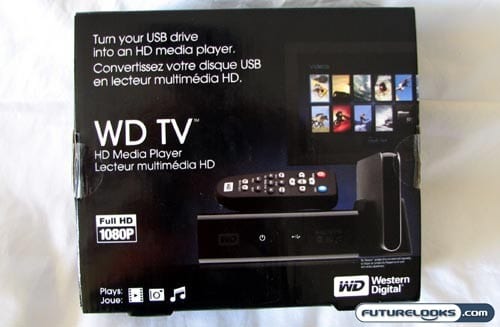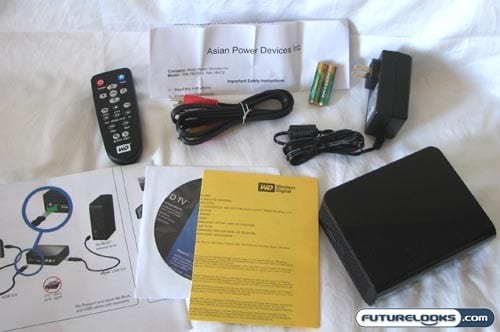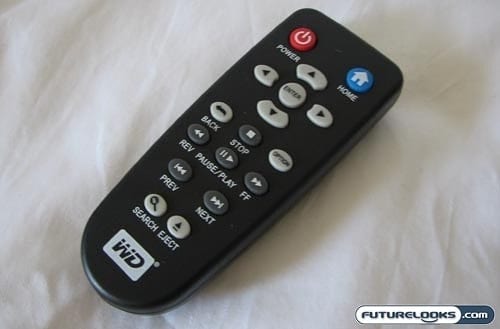As much as I like my trusty little laptop, I’d much prefer to watch my HD movies on my HDTV. That much makes sense, but when you get the majority of your digital content through the Internet on your computer, what’s the easiest way to send that content over to the home theatre in your living room?

Some time ago, we took a look at the Seagate FreeAgent Theater and today we turn our attention to the competing product from Western Digital: The WD TV HD Media Player. Effectively, you are able to take the multimedia content stored on nearly any USB device and deliver it to the big screen and big speakers of the home theatre in your living room.
How does the WD TV stack up against other similar solutions? Let’s find out.
Features and Specifications
The WD TV HD Media Player acts, essentially, like a set-top box that you attach to your television. Working much like a DVD player or any other piece of home theatre equipment, it can feed media content to your home theatre or external speakers and an HDTV. The difference is that all of this content is being fed through a USB connection to the WD TV instead of a coaxial cable to your set top box.
Unlike the Seagate FreeAgent Theater, this product does not come bundled with any storage of its own. You have to provide that. They say that it is optimized to work with the My Passport and My Book portable hard drives from WD, but you can use just about any USB hard drive or flash drive on the market. Assuming that it is compliant with USB Mass Storage, you can even connect your camera, camcorder, or MP3 player directly.
Like the Hi-Den Vision, the WD TV will also output your content at up to 1080p high-definition. Naturally, the content itself will need to be encoded at that resolution too. In addition to videos, this will also do photos and music in various formats which we will go over later.
Looking Inside the Box

Popping open the attractively-designed box, you’ll find the HD Media Player itself, as well as a small remote, media converter software, a composite AV cable, AC adapter, and a Quick Install guide. Since the WD TV can handle HD video, I do find it a little disappointing that they’ve only included a composite AV cable. As it stands, the bundle will not fully utilize its HD capabilities due to the lack of an HDMI cable.
Remote Control Only

It seems that the norm when it comes to many of these types of media players is to pack as slim a credit card-style remote control as you can. Thankfully or regrettably, Western Digital did not take this approach with its remote for the WD TV. Instead, it’s a pretty normal looking remote in a pretty normal size.
Interestingly, I found that there are absolutely no buttons or controls on the set top box itself. You can’t even turn it on, as far as I can tell, from the media player. Instead, absolutely everything is controlled by the remote. I guess it’s a good thing that the remote isn’t easy to lose.
That’s One Tiny Media Player
Compared to the Seagate offering, the WD TV is quite a bit smaller. This is largely because the WD TV HD Media Player does not have a slot built into it that is meant to accept a full-sized external hard drive. Instead, the interface is through a standard USB connection, so your flash drives and hard drives will be sitting outside of the media player itself.
Being so much smaller, it is quite easy to accommodate this shiny black box of multimedia goodness in your living room. Contrast this, perhaps, to using the media player function on an Xbox 360. I know a few people who use their 360s primarily for media playing. The Western Digital option certainly has a smaller footprint.
Hurray for HDMI Output and Dual USB Inputs
Swinging around to the back of the WD TV, you’ll find an assortment of ports and jacks. While there is no support for component video, you can take the generic standard definition route of the provided composite cable. You can, but you don’t want to do that.
That’s because the WD TV has an HDMI port, offering you true 1080p digital video and audio. This is utterly fantastic for just about any contemporary HDTV, since it’s just one cable. No mess, no confusion. If you prefer, you can also take advantage of the optical out for 5.1 surround sound audio when connected to your home theatre receiver. That’s a huge plus and a major advantage over some of WD’s competitors.
Aside from that, there’s a single USB port back here for your storage media and the port for the DC power adapter.
This is going to be a design feature that you’ll either love or hate. I thought that it was unfortunate that there is a USB port in the back of the WD TV, because this isn’t all that accessible if you’re going to be swapping flash drives on a fairly regular basis. That’s partly why Western Digital included a USB port on the side as well.
I like having dual inputs, but wouldn’t it have made more sense to have the second USB port on the front? Even the decidedly cheaper and less attractive media player from Hi-Den does it that way. That said, by not placing a USB port on the front, Western Digital is able to maintain a much cleaner look overall.
File Format Compatibility
The main reason why you’d want to get something like the Western Digital WD TV HD Media Player is to watch video files on your massive HDTV, but it’s just as capable when it comes to photos and music as well. In fact, the list of file formats supported is among the best in the business, outdoing the Seagate FreeAgent Theater and even the Xbox 360.
For music, it’ll do MP3, WMA, OGG, WAV/PCM/LPCM, AAC, FLAC, Dolby Digital, AIF/AIFF, and MKA files. For photos, it’ll handle JPEG, GIF, TIF/TIFF, BMP, and PNG formats. Most of these other photo viewers can restrict you to just JPEGs.
On the video front, the WD TV can handle MPEG1/2/4, WMV9, AVI (MPEG4, Xvid, AVC), H.264, MKV, MOV (MPEG4, H.264), MTS, TP, and TS formats, including support for subtitles (SRT, SMI, SUB, ASS, SSA). The inclusion of support for MKV and MOV files is huge, especially for people who download content from overseas where the MKV format is much more popular.
It might have been my specific video file, but I tried one MOV file (from my P&S digital camera) and it would not recognize the audio in it. The video played just fine though, so I’m not entirely sure what happened. Something about the audio codec, I suppose.
Very Pretty User Interface, But…
Let’s start with the good stuff. The on-screen interface for the WD TV looks fantastic, working as a series of horizontal and vertical ribbons that are easily navigated using the four arrow keys on the remote controls. The icons remind me a little of what you’d find on a Palm Pre or similar smartphone.
Unfortunately, there’s one thing that makes this experience a little frustrating. When the room has a little more ambient natural light, it seems that the remote is not nearly as responsive as it can be. Sometimes it won’t pick up the signal and other times, it’ll act as if one of the arrow buttons is stuck. I’d recommend you use the WD TV under slightly dimmer conditions.
In terms of the video-playing experience itself, I thought it worked just fine. It’s nothing anything that would go above and beyond some of the other offerings on the market, but I’m pleased with the 1080p video quality and even the less-than-stellar videos from my digital camera end up looking half decent.
Eject Your USB Media Please
I didn’t know I still had to do this. Even on my main notebook computer, I don’t really go through the process of “safely removing” any USB hardware from my computer anymore; I just make sure that any file transfers are complete and I assume that I’m reasonably good to go.
This is the approach that most home theatre media players tend to take as well, but not Western Digital. There is an option in the menu to “eject” your USB device. I thought it was an interesting inclusion, particularly since they offer two USB ports.
Final Thoughts and Conclusion
At about a hundred bucks, the WD TV HD Media Player from Western Digital certainly offers several advantages over some of its direct competitors. It’s great to see a true HDMI connection here for 1080p video and it’s even better that they have taken the care to include an optical audio out as well.
The user interface is clean and attractive, making it easy to sort through all of your multimedia content based on date, folder, or just looking at absolutely everything. The remote is pretty basic and this wouldn’t be horrible if it weren’t for the somewhat quirky connection issues noted. A remote should just work, shouldn’t it?
It may not come with any storage of its own, unlike the Seagate FreeAgent Theater, but you can easily grab a couple of flash drives on your own. Where the WD TV really shines, though, is in file format support. Tossing in the love for MOV and MKV files will go a long way, even if most of us prefer AVI and MPEG-1/2/4.
There’s no wireless streaming, but among the set top box-style HD media players, the WD TV is a solid choice.
Pros
- Fantastic file format support
- Incredibly small form factor
- Great-looking user interface
- HDMI, dual USB, and optical audio out
Cons
- Remote has strange transmission problems
- No wireless (or even wired) streaming
- No included storage
- MOV file did not play audio (codec issue?)
Overall Rating: 8.5/10
Discuss This Review in the Futurelooks Community Forums
Western Digital WD TV HD Media Player Photo Gallery
